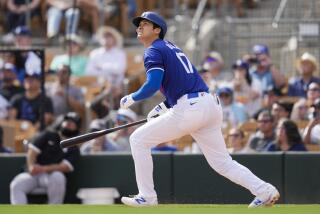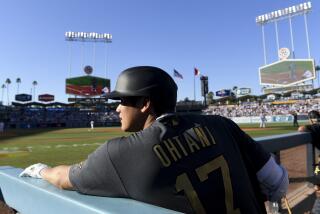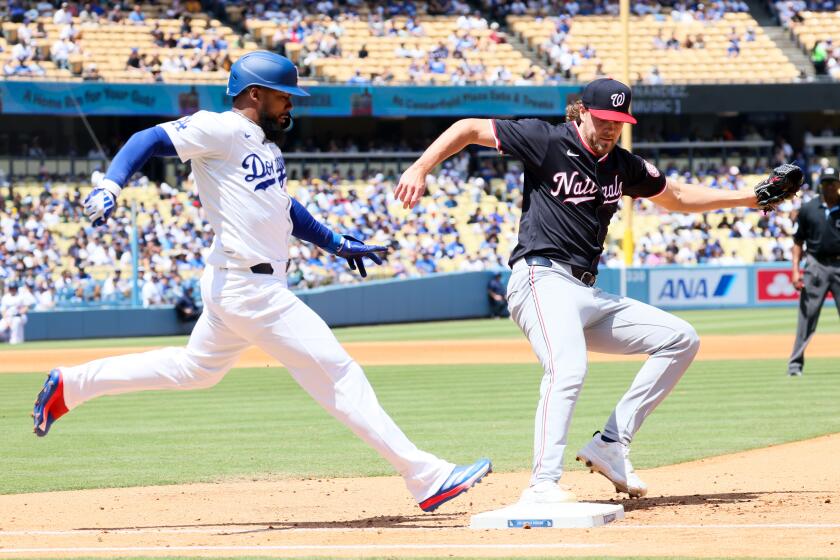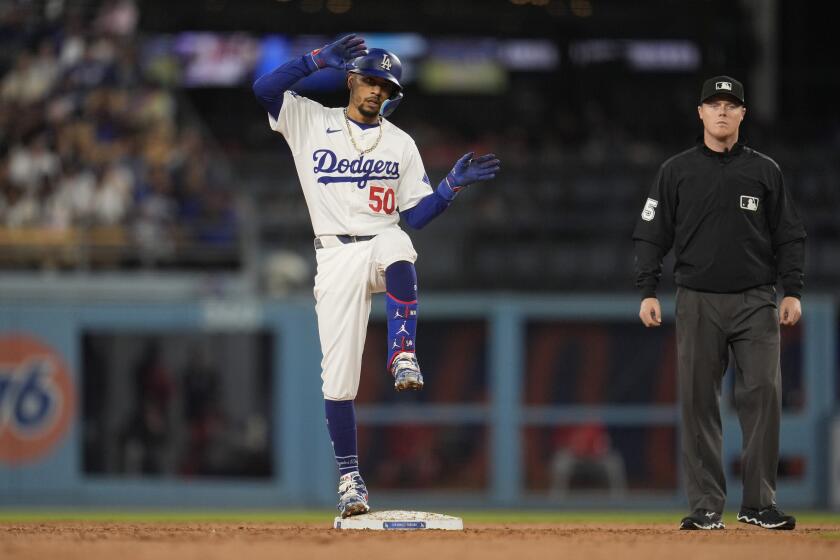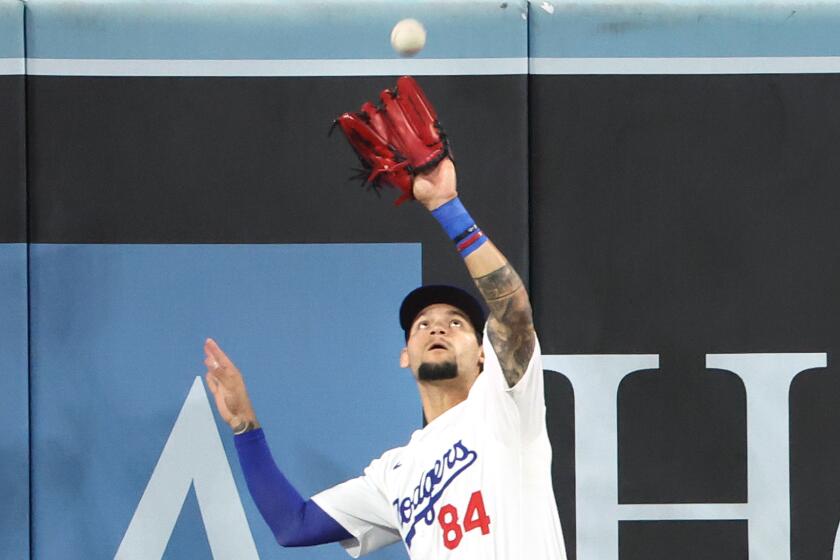Dodgers Dugout: Who are the three best second basemen in team history? (And results of top 3 first basemen)
Hi, and welcome to another edition of Dodgers Dugout. My name is Houston Mitchell and it’s time to continue selecting the all-time 40-man roster for the Dodgers.
The all-time team, second base
Before we get to second basemen, let’s again lay down the ground rules on who is eligible for the polls.
First, we are only counting what they did as a Dodger. Frank Robinson is one of the greatest players of all time, but he only played one season with the Dodgers, so he won’t be appearing here.
Second, position players had to play at least 500 games with the Dodgers, or have had such an iconic moment or season with the team that it wouldn’t make sense to leave them off. (It’s the Kirk Gibson rule.)
Third, only games played since 1901 count. My apologies to those who played before then.
Fourth, players who competed at multiple positions will be listed at the position where they played the most games for the Dodgers. Jim Gilliam played multiple positions for the Dodgers, but he played the most games at second base, so he is listed there today.
Finally, you can vote for three players at each position. There will be a link to a site where you can make your selections at the end of each player list.
With that, let’s get to it. There are 12 second basemen who meet the criteria for the Dodgers. Let’s look at them using three stats: OPS+ (on-base percentage plus slugging percentage, which compares them to the league-average hitter each season, making it easier for us to do cross-era comparisons; a league-average hitter will have an OPS+ of 100), WAR (wins above placement, which shows career value) and defensive WAR (which gives a general idea of how well they fielded). Those three stats don’t give a complete picture, but it should give you an overall sense of the value of each player. I encourage you to do further research on each player if you are unsure about them.
OPS+
Jackie Robinson, 132
Jeff Kent, 119
Davey Lopes, 105
Eddie Stanky, 105
Jim Lefebvre, 104
Tony Cuccinello, 104
John Hummel, 102
Steve Sax, 97
Charlie Neal, 93
Jim Gilliam, 93
Mark Grudzielanek, 90
George Cutshaw, 89
WAR
Jackie Robinson, 61.4
Jim Gilliam, 40.7
Davey Lopes, 32.3
Jim Lefebvre, 17.2
Steve Sax, 15.9
Eddie Stanky, 14.8
John Hummel, 11.3
Charlie Neal, 9.6
Tony Cuccinello, 9.3
George Cutshaw, 9.3
Mark Grudzielanek, 7.0
Jeff Kent, 6.8
Defensive WAR
Jackie Robinson, 10.1
Jim Gilliam, 8.2
Jim Lefebvre, 4.8
Davey Lopes, 3.8
Eddie Stanky, 3.0
George Cutshaw, 2.3
Mark Grudzielanek, 2.1
Tony Cuccinello, 0.7
Charlie Neal, 0.2
Steve Sax, -2.0
John Hummel, -2.4
Jeff Kent, -3.9
A closer look at the players (statistics are with Dodgers only):
Tony Cuccinello (1932-35, .271/.334/.410): After two excellent seasons with Cincinnati, Cuccinello refused to sign the contract the Reds offered him so they traded him to the Dodgers. He played in every game for Brooklyn in 1932, hitting .281 with 32 doubles and 12 homers. He was named to the first All-Star game in 1933 and made the last out in the game. He had great range at second and was good at turning the double play. After four solid seasons with Brooklyn, he was traded to the Boston Braves. He retired after the 1945 season and became a longtime coach, mostly for manager Al Lopez, whom he met while the two played for the Dodgers.
George Cutshaw (1912-17, .260/.303/.342): Cutshaw was fast, stealing 166 bases with the Dodgers, still 21st in team history. There’s not a lot of information readily available about Cutshaw. He was traded after the 1917 season along with Casey Stengel to Pittsburgh for Burleigh Grimes. Cutshaw died in San Diego in 1973 at age 87.
Jim Gilliam (1953-66, .265/.360/.355): It seemed that every season Jim Gilliam would be on the bench, squeezed out of the lineup by a hot rookie or flashy newcomer, then by the end of April, either the new player would be a bust or an injury would open a spot and Gilliam would end the season as the starting second baseman. Or starting third baseman. Or starting left fielder. But allow me to use this space to recount a story Vin Scully told me about Gilliam for my book:
“I was introducing the team, and I would introduce, ‘So and so is the shortstop’ and so on, and I introduced Jim as ‘Jim Gilliam, baseball player.’
“He was one of the smartest players. I remember Walter Alston saying that Jim never missed a sign. Never. Like anyone else, you are going to drop a ball, you are going to make an error, but Jim never made a mental mistake. And on the base paths, he’d go from first to third all the time. He always did the right thing.
“He was very quiet and not at all ‘on,’ but he was a consummate baseball player.
“He was married in St. Louis, and the team bus stopped at the reception while the photographer was taking pictures. Jim said to the photographer, ‘One more.’ The photographer took it and Jim got on the bus and we went to Busch Stadium.
“He was the ultimate. Quiet, just great.”
The Dodgers retired Gilliam’s number, 19, shortly after he died after the 1978 season. He remains the only Dodger whose number has been retired who is not in the Hall of Fame.
Mark Grudzielanek (1998-2002, .284/.328/.389): Grudzielanek is like a lot of second basemen on this list. He wasn’t great, he wasn’t bad, he was just sort of there. He filled the position and did his job. His best season was 1999, when he hit .326 with 23 doubles. It was his only above-average season on offense with L.A., and let’s just say he wasn’t exactly piling up Gold Glove awards either. He was traded after the 2002 season along with Eric Karros to the Cubs for pitcher Chad Hermansen and catcher Todd Hundley. He was a minor-league manager for the Chicago White Sox last season.
John Hummel (1905-15, .253/.315/.351): Hummel was a Jim Gilliam if Gilliam had played (or been able to play) 50 years earlier. He played almost every position and spent so much time with the Dodgers he was given the nickname “Methuselah.” In a sign that not much has changed from one generation to the next, he disdained the advance of the “lively ball” era after he retired, saying, “In the good old days, we played heart and soul for one run, whereas now they play for 10 or 12.” Hummel died in 1958 at age 76. He probably won’t draw many votes in this poll, and probably doesn’t deserve many. But his name deserves to be remembered.
Jeff Kent (2005-08, .291/.367/.479): Kent played for 17 seasons, the final four with the Dodgers. He was great in 2005, hitting .289 with 29 homers and 105 RBIs, but injuries hampered him in 2006 and he retired after the 2008 season. He was never much defensively, and fans seemed to have a hard time warming up to him, but he was a solid player.
Jim Lefebvre (1965-72, .251/.323/.378): Lefebvre was named National League rookie of the year with the team in 1965, a strange vote because Houston’s Joe Morgan was better than him in almost every category you can think of. In the same number of games, Morgan had 43 more runs scored, 27 more hits, two more homers, 17 more steals and 26 more walks along with a higher batting average, on base percentage and slugging percentage. In 1965, he was part of a Dodger infield that was the first regular infield made up entirely of switch hitters, joining Jim Gilliam, Maury Wills and Wes Parker. He did his job, made the plays he needed to play and was the first person in baseball history to win a World Series (1965) and the Japanese version of the World Series, with the 1974 Lotte Orions.
Davey Lopes (1972-81, .262/.349/.380): There were certainly more prolific base stealers in baseball history, but there may have never been a better base stealer than Davey Lopes. In 1975, he led the NL with 77 steals and was caught only 12 times. In 1976, he led with 63 steals and was caught only 10 times. At the age of 40, he stole 47 bases and was caught only four times. Admittedly, that was with the Cubs, so it doesn’t count for our purposes, but it’s my favorite Lopes stat.
Charlie Neal (1956-61, .265/.334/.409): Neal’s claim to fame with the Dodgers came in 1959, when he led the NL in sacrifice hits and triples and hit .370 in the World Series victory over the Chicago White Sox. He also won the Gold Glove that season. He was traded to the Mets after the 1961 season and was out of the majors two years later at the age of 32.
Jackie Robinson (1947-56, .311/.409/.474): Forget for a moment (and it’s a big thing to ask, because we should never forget) that he broke the color barrier and all the sickening abuse he had to take. The man was a great baseball player. He was great defensively at every position he played. He was rookie of the year. He was National League MVP. He never had a bad season.
Steve Sax (1981-88, .282/.339/.356): Sax was a fan favorite, but when you look back at his numbers, he wasn’t really all that good. His best season was 1986, when he hit .332. He was a leadoff man who never scored 100 runs, had low on-base percentages and was not a great base stealer. Sure, he stole 56 bases in 1983, but he was caught stealing 30 times. He famously had a mental block for most of the 1983 season that made him throw routine grounders into the stands behind first base. My favorite Sax story comes from Tommy Lasorda, which brings its accuracy into question. One season, Pedro Guerrero was playing third base for the Dodgers and having a brutal time on defense. Lasorda called him into his office before a game to boost his confidence. “Pedro, two out, bases loaded, we are down by one. What are you thinking?” Guerrero answered, “I’m thinking I want to be batting, because I will get a hit.” Lasorda: “That’s exactly what you should think. Now, two out, bases loaded, we are up by one. You’re playing third base. What are you thinking?” Guerrero: “I’m thinking, ‘Please don’t hit the ball to me.’ ” A frustrated Lasorda asks, “Is that all you are thinking?” Guerrero answers, “No, I’m also thinking, ‘And please don’t hit the ball to Steve Sax.’ ”
Eddie Stanky (1944-47, .263/.405/.336): Stanky was a spark plug and an agitator who led the league in walks two times with the Dodgers, including a career-high 148 in 1945, when he also led the league in runs (128). He was short for a player (5-8) and weighed 170 pounds if someone was standing behind him putting a foot on the scale. Many people still believe he didn’t like Jackie Robinson, but recent research calls that into question. Both Branch Rickey and Robinson himself said shortly after the 1947 season that Stanky was one of Robinson’s biggest supporters on the team. He was traded to the Boston Braves after the 1947 season to open up a spot at second base for Robinson. He coached baseball at Southern Alabama for years and sent 43 players to the majors. He died in 1999 at the age of 83.
Now it’s time for you to vote. Remember to vote for three. You can click here to vote, or you can email me your three choices. Ties are not allowed, and you have to vote for three. Vote for more or fewer and your vote won’t count.
Next week: Third base. I’m predicting a landslide win for German Rivera.
Who were the three best first basemen?
You voted. Here are the results, after receiving 16,212 ballots:
1. Gil Hodges (named on 95.5% of ballots)
2. Steve Garvey (90.2%)
3. Wes Parker (49.6%)
4. Eric Karros (22.1%)
5. Dolph Camilli (21.8%)
6. Adrian Gonzalez (16.5%)
7. Jack Fournier (1.6%)
8. Jake Daubert (1.0%)
9. Franklin Stubbs (0.7%)
10. Del Bissonette (0.6%)
11. James Loney (0.3%)
12. Tim Jordan (0.1%)
And finally
Davey Lopes hits two home runs and has five RBIs in Game 1 of the 1978 World Series. Watch here.
Have a comment or something you’d like to see in a future Dodgers newsletter? Email me and follow me on Twitter: @latimeshouston.
More to Read
Are you a true-blue fan?
Get our Dodgers Dugout newsletter for insights, news and much more.
You may occasionally receive promotional content from the Los Angeles Times.


